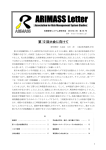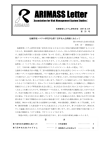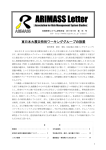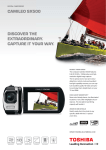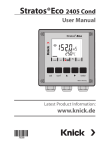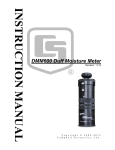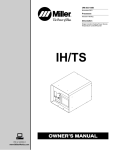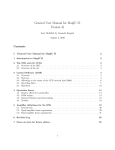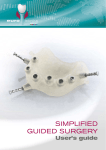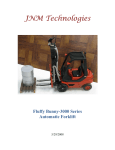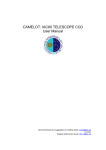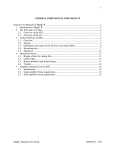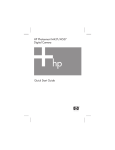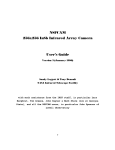Download LSO-MAN-ESO-90100-00..
Transcript
SUSI2 file:///home/fselman/opa/docu/LSO-MAN-ESO-90100-0012/src/susi... European Southern Observatory La Silla Observatory La Silla SciOps SUSI2 Superb Seeing Imager - 2 Direct CCD Imaging Camera at the NTT User’s manual Doc. No. LSO-MAN-ESO-90100-0012 Issue 1.10 November 29, 2004 Keywords: SUSI2, Manual, NTT Prepared: Approved: Released: M. Billeres O. Hainaut O.Hainaut 2002 August. 2002 August 2002 August (see table at the end for minor releases) Table of content : 0- Introduction 1-Instrument overview 2-Instrument Properties: 2.1 Optical Parameters 1 of 14 11/30/04 04:11 SUSI2 file:///home/fselman/opa/docu/LSO-MAN-ESO-90100-0012/src/susi... 2.2 CCDs 2.3 Photometry and Throughputs 3-Observing with SUSI2 3.1 Generalities 3.2 Hints Annexes : Filter Transmission curves 0. Introduction This manual describes the SuSI2 instrument on the ESO New Technology Telescope at La Silla Observatory. It is meant for the observers preparing observations on that instrument, or processing data produced with SuSI2. The manual exists only in HTML. The on-line version has many in-line links to other pages. Nevertheless, a printed version from this document will contain all the relevant information: links that point to critical information are given in clear in the text, the others are for general or background information. 1. Instrument Overview The NTT Nasmyth focus A hosts since 1998 two new instruments: the IR imager-spectrometer SOFI and the direct imaging CCD camera SUSI2. The latter is an upgrade version of the SUperb Seeing Imager identical in concept (imaging at the f/11 focus of the telescope with one additional reflection) but with a 4 times larger field (5.5 x 5.5 arcmin). SUSI2 incorporates the first version of new ESO controller FIERA with a mosaic of two 2k x 4k, 15 µm pixel, thinned, anti-reflection coated EEV CCDs. Other novel features of the instrument are an 8cm x 8cm sliding curtain shutter which permits uniform exposures down to 0.3 seconds and a special cryostat designed to operate on a rotating Nasmyth adaptor. SUSI2 and SOFI share the same mechanical structure attached to the Nasmyth adaptor flange and the same cable derotator. The direct beam from the telescope feeds SOFI. A 45° mirror is inserted in the light path when SUSI2 is in operation. This manual is extensively based on the SusI-2 commissioning report and on the preliminary manual by S. d’Odorico and G.Martin. 2. Instrument properties 2.1 Optical parameters Optical Components in the Light Path: The optical path of SUSI2 includes the three mirrors of the telescope, the 45° reflection prism with a multi-layer coating (reflection efficiency > 90% in the range 340-500 nm; > 95% in the range 500-1100nm; this prims is known as "Mirror 4" in the NTT jargon) and the coated quartz window of the cryostat (transmission > 97% over the range 340-1100 nm). The filter wheel and the shutter are located in the f/11 between the prism and the cryostat. Before Nov.1999, there was a small vignetted region at the bottom the the CCDs (~500pix). While the vignetting was flat-fielded out, this region should not be used for accurate photometry. The vignetting was caused by the mirror 4, whose position has been adjusted. 2 of 14 11/30/04 04:11 SUSI2 file:///home/fselman/opa/docu/LSO-MAN-ESO-90100-0012/src/susi... Filters: The filter wheel has 6 positions. The filters have a diameter of 100 mm. The filters currently available are listed in the table below. Bessel U #810 Bessel B #811 Central wavel. 357.08 421.20 Bessel B #817 421.17 Bessel V #812 544.17 Bessel R #813 641.58 Bessel I #814 794.96 Bessel Z #815 840.90 r #822 IB 609 #830 IB 662 #831 WB 490 #824 WB 665 #825 U’ #823 609.38 662.29 502.72 665.67 368.97 Filter ID He II #880 H Beta #881 O III #882 O III/Cont #883 H alpha #884 H alpha/Cont #885 469.531 486.438 500.984 511.061 655.528 Table 1: SuSI2 filters. FWHM PWL Transm. Red leak and remarks % 52.07 360.5 58.6 98.94 417.4 69.1 0.01% @ 1100nm 0.02% @ 1200nm 99.17 419.0 69.1 spare 0.01% @ 1100nm 115.17 526.0 89.4 0.02% @ 1200nm 0.06% @ 1100nm 158.89 597.0 86.9 0.04% @ 1200nm 0.13% @ 1100nm 147.82 797.5 88.9 1.63% @ 1200nm high Atmospheric + CCD cut off at large 1126.0 98.2 pass wavel. not measured. Use at your own risk 27.16 610.0 88.9 Not available anymore 35.4 665.0 91.7 Not available anymore 107.32 510.0 87.5 123.52 679.0 97.4 low pass. 339.0 81.0 Atmospheric + CCD cut off at small wavel. Maximizes transmission at l<370nm. 7.644 469.0 72.2 6.668 485.5 83.2 7.244 500.0 86.1 7.019 510.5 84.2 = O III 6000km/s 6.976 656.5 89.5 - 668.655 6.899 669.0 90.3 = H alpha 6000km/s Notes on the filters: It was though for a while that Filter B#811 was causing an elongation of the image in case of very good seeing. This could not be confirmed; indeed B#811 gives images of excellent quality. Filters IB 609 and IB 662 are not available anymore. Additional information (incl. transmission plots) are available in Annex A, or on the La Silla Instrumentation web page ar http://filters.ls.eso.org/efs/, or from the team. Remark the very high peak transmission of these filters (up to twice that of similar filters in EMMI). Because of their extremely high costs, we do not plan to purchase any additional filters. If you need currently unavailable filters, you can send us ([email protected]) a request with 3 of 14 11/30/04 04:11 SUSI2 file:///home/fselman/opa/docu/LSO-MAN-ESO-90100-0012/src/susi... a scientific justification. However, be aware that it is unlikely that we have funds to acquire the filters. Special filters can be mounted in SuSI upon request (with advance notice). The filters must respect the following specifications: Diameter < =100mm Thickness < 10mm Filters with a dimeter < 100mm must be mounted in an adaptor. We have a set of such adaptors for some standard diameters, and we can manufacture adaptors for other diameters. It is critical to organize this in advance. Be warned that it is very likely that special filters will have a different optical thickness than the standard filters, causing a focus offset that will have to be measured and cause some additional overhead during the observations. 2.2 CCDs The two EEV CCD 44-80 were the first in the large format with 2 x 4 k, 15µ pixels in operation for astronomy. Their properties when operated with the FIERA controller are summarized below: Data Format, Read-out Time and Read-out Noise: The two EEV chips are identified as ESO CCD # 45 and 46. The two frames are combined in a single FITS file (chip #45 has lower x values, i.e. on the left on standard display); the space between the two chips has been "filled" with some overscan columns so that the respective geometry of the two chips is approximatively preserved. The format of the file is 4288 x 4096. Along the x axis there are 50 prescan, 2048 active, 46 overscan pixels for chip # 45, followed by 50 prescan, 2048 active and 46 overscan for chip # 46. There is one single read-out option in which the two chips are read in parallel each through a single port at 2 x 105 pixels/sec. There are three binning options (unbinned=1x1, 2 x 2 and 3 x 3) and the possibility of defining a single read-out window (which can overlap with both chips). The read-out times (intervals from the closure of the shutter to the display of the image in the Real Time Display monitor) are 56, 16 and 9 seconds for the three binning options respectively. On the RTD, the default options show North at the top and West (chip # 45) to the left. The measured read-out noise are: 4.7 e- for (# 45) and 4.6 e- for (# 46). For the latest measurements of the CCD parameters, pls check the NTT detector page at http://www.ls.eso.org/lasilla/sciops/ntt/CCDs/CCDs.html on the WWW (updated ~weekly). This page also links to an history of these parameters’ evolution. CCD QE: Measurements of the Qes for the two chips in the ESO detector laboratory show that # 45 is up to 5% relatively more efficient than # 46. The table below gives the average values: Table 2: SuSI2’s CCDs quantum efficiency nm 350 400 500 600 700 800 900 1000 % QE 76 90 84 80 68 48 23 4 Saturation and Linearity: Pixel saturation occurs at ~ 150000 e-. With the adopted gain of ~2.25 e- /ADU this corresponds 4 of 14 11/30/04 04:11 SUSI2 file:///home/fselman/opa/docu/LSO-MAN-ESO-90100-0012/src/susi... approximately to the full rang e of the ADC converter in the unbinned mode . The CCDs have been found linear within + 0.15% over the full range 0-60000 ADUs. Charge Transfer Efficiency: Both serial and horizontal CTE are better than 0.999999. CCD dark current: <0.5 e-/pix/hour, i.e. negligible for all practical purposes. Bias Level: To be derived from the average of prescan and overscan regions of each frame because of a slight dependence on the mean level of the charge in each row of the CCD. 0sec bias exposure average at ~300adu. (again, check the NTT detector web page for up to date values) Figure 1: Example of SUSI bias: the difference of sensibility bewteen the two CCDs is responsible for the contrast. Cosmetics: Chip #45 (left) present ~15 bad columns, while #46 has some blemishes that look quite bad but actually flat-field out very well. Image scale, Field Size, Image Quality: The scale at the Nasmyth focus of the NTT is 5.4 arcsec/mm. The measured pixel scale is 0.085 arcsec/pixel (0.161 arc/sec in the 2 x 2 binned mode). Each chip of the 2x1 mosaic covers a field of 5.5 x 2.7 arcmin. The gap between the chips corresponds to ~ 100 real CCD pixels, or ~ 8 arcsec. In the default position of the rotator the gap runs in the N-S direction. The optical axis -which is also the reference for pointing- is at about 60 pix left of the center of the mosaic, i.e. in chip #45 (left), very close to the inter-CCD gap. The angular misalignment between the two chips is smaller than 6 arcmin. Very accurate astrometry requires an independent calibration of the two subfields. The table below lists the mean astrometric parameters over the two chips. Variable 5 of 14 X coefficient Y coefficient 11/30/04 04:11 SUSI2 file:///home/fselman/opa/docu/LSO-MAN-ESO-90100-0012/src/susi... X Y XY X2 Y2 +0.02239 +0.00013 +0.00005 -0.00004 -0.00004 -0.00033 +0.02231 +0.00004 +0.00003 -0.00001 No aberrations or change of focus have been detected over the full field covered by the mosaic down to an image quality of 0.5 arcsec FWHM. The chip geometry is summarized in Fig.1, with the effect of an additional Rotator Offset. Figure 2: Orientation of the SuSI2 detectors 2.3 Photometry and Throughputs The photometric parameters have been determined during the commissioning of the instrument, and are measured regularly as part of the Maintenance Plan of the NTT. Typical values (for 2001) obtained using several Landolt standard fields are presented hereafter for the Bessel filters. It should be noted that the zero points show a slow decrease over the past two years, which is being investigated. Obviously, these values should be used only as reference: careful observers will re-measure them during their run. This is specially true for the Zero Points, whose values are strongly affected by the normalisation region used when preparing the flatfields. Up to date values can be found at : http://www.ls.eso.org/lasilla/sciops/ntt/susi/docs/susiCounts.html Table 3: SuSI2 Photometric Calibration (typical 2001 values, zero points in ADUs) U B V R I - u b v r i = = = = = 0.10(U-B) -0.22(B-V) -0.02(V-R) -0.05(R-I) -0.10(R-I) + + + + + 23.52 25.46 25.70 25.60 24.60 For the purpose of observation preparation, an exposure time calculator for SUSI2 is available at this web site. It computes the counts of the instrument based on the optics and CCD data as they are known now. The results are in good agreement with the number of photo-electrons measured at the telescope. The table below gives the average measurements normalised to a star of 15 6 of 14 11/30/04 04:11 SUSI2 file:///home/fselman/opa/docu/LSO-MAN-ESO-90100-0012/src/susi... magnitude, in one second exposure and at 1 airmass, for two epochs. The stability of countrates is excellent, as illustrated by the evolution curves displayed at the above web page. Table 4: Count rates (in adu) on SUSI2, for a mag=15 star, arimass=1 Band U B V R I CCD#45 4780 31200 46050 45100 18200 CCD#46 4690 30840 45770 44920 17950 3. Observing with SuSI2 3.1 Generalities SuSI2 is entirely operated within the VLT observation scheme: "Observation Blocks" are prepared the days before the observations using P2PP, and executed at the telescope. It is also possible to create, copy and modify the Observations Blocks at the telescope; actually, the most efficient way to observe (in visitor mode) is to prepare in advance all your Target Packages and Observation Descriptions, while preparing only models of Observing Blocks, which you will duplicate and modify while observing. If the last sentence does not make any sense to you, don’t dispair: your support scientist will introduce you to P2PP. You may also want to read the P2PP User’s Manual, a complete, detailed, reference document. The instrument templates (describing the different possible observations, calibration and target acquisition) are operationally identical to those which have been used with the previous SUSI imager, and are described in details in the SuSI2/EMMI Template Signature File Parameters Reference Guide. A short summary is given in the table below. Curious readers can consult the EMMI user manual for a longer description of the VLT observation scheme at the NTT. Note that as of Period 68 (Oct.2001), a new set of SuSI2 observations templates has been introduced (known as SuSI2001). As of Period 69 (April 2002), the old templates are not supported anymore and new OBs must be prepared using SuSI2001. 7 of 14 11/30/04 04:11 SUSI2 file:///home/fselman/opa/docu/LSO-MAN-ESO-90100-0012/src/susi... Table 5: SuSI2001 Templates Template Acquisition Templates SUSI_img_acq_Preset Correspondance with old template Description SAT01 Open loop (blind) pointing Target field at location (brings the object to a given pixel after taking a short acquisition image) SUSI_img_acq_MoveToPixel SAT02 Observation Templates SUSI_img_obs_Exposure SUSI_img_obs_Jitter SOT01 SOT02 SUSI_img_obs_DoubleW - Calibration Templates SUSI_img_cal_Dark SCT01 SUSI_img_cal_DomeFF SCT02 SUSI_img_cal_SkyFF SCT03 SUSI_img_cal_TelFocus SCT04 Single image Multiple images with dithering (offsets) Reads two non overlapping subwindows (for fast photometry) Biases and Darks Dome flat-fields (request a series of flat at a given level) Twilight flat-fields (request a series of flat at a given leve, computed taking into account a model of the sky brightness de/increase) Through-focus sequence 3.2 Hints This section lists a collection of hints and tips for observing with SuSI2. At this point it is not ordered in a very coherent way. Central gap: Remember that there is a 8" gap between both chips, that the optical axis (i.e. the reference for pointing) if in CCD#46 (left) very close to the gap, and that NTT points very well. If you just preset to the coordinates of a star, your object can fall into the gap. You can either add/subtract 1-2 arcsec to the RA of the star (beware of the cos(dec)) or start your sequence with an offset (e.g. in a SUSI_img_obs_Jittertemplate). As the space between the CCD is masked, the central gap can be used as a crude coronograph to mask a bright star. To accurately point an object in the gap, use the SUSI_img_acq_MoveToPixel acquisition template. Standard stars: Although both chips are very similar, you may want to photometrically calibrate them separately if a very accurate calibration is required. An efficient way to do so is to observe each standard field through all your filters, then rotate the rotator by 180deg and do the same sequence again. In that way, all the stars that were on one chip during the first sequence will fall on the other chip for the second sequence, ensuring that both are calibrated exactly in the same way. The rotation takes ~20sec. In practice, you can define an 8 of 14 11/30/04 04:11 SUSI2 file:///home/fselman/opa/docu/LSO-MAN-ESO-90100-0012/src/susi... OD with your standard exposures, and link it in two different OBs, one with a 0o rotator offset in the aquisition template (SUSI_img_acq_Preset), the second with a 180o offset. The jp2pp-impex-stdcal directory of the NTT machines (both off- and on-line) contain a set of pre-defined OBs for selected Landold fields, for standard read-out modes, and for 0 and 180deg rotation. Jitter and super-flatfield: To obtain a very good flat-field, it is criticalto use the "super-flat" technique (introduced by Tyson, developped by Tyson, Lilly, and others), which consists in utilizing the scientific images themselves as flatfield. In order to do so, the telescope should be moved (jittered) between each exposure. The size of that jitter should be of the order of 2x the largest object in the field. The jitter pattern should be chosen depending on the total number of exposures on each field, remembering that there is a vertical gap between the chips (i.e. never do an offset along the y axis). For a small number of exposures, a tilted grid gives good results. For larger number of exposures, consider taking the exposures moving the telescope on a "star-like" pattern, all the positions falling on a circle (typical radius = 15"), or, even better, taking the offsets at random within a disk of ~15" radius. If your object is very large, consider moving the object from chip to chip after each exposure, as one would "nod" the telescope for Infra-Red observations. Fringes in I: Images obtained in the I filter present some strong fringes, caused by the interferences of night sky lines in the thin CCDs. As the flat fields are obtained with white light, they do not correct these fringes. Moreover, the fringes correspond to an additive pattern, and should therefore be subtracted, and not divided. To correct them, the fringe pattern has to be extrated from the scientific images themselves. The following procedure gives very good results; it should be however noted that, as the flatfielding of the frames, the corrections of the fringes can be performed in several different ways. This procedure is the simplest that gives good results. Obtain the observations with a large dithering pattern; be sure to have at least 5 long exposures in I, ideally at least 5 per field. Subtract the bias from all frames Normalize the sky level of all your I exposures to the average sky level (you may want to work field by field). Store the normalization factor for further use. Median average all the I exposures (again, you may want to work field by field); the result should contain no object, just the fringes and the flat-field structure. Divide the result by the twilight I flat; you are left with a flat sky and the fringes (which have also been divided by the flatfield which they should not. This will be corrected later). Get the average sky level and subtract it( you want to have an image with a mean~ zero) ; you are left with the flatfielded fringes alone. Multiply the result by the flatfield: this is your master fringes template. For each image, multiply the master fringe template by the normalization factor you used for that image. Subtract the result from the original image Divide the defringed frames by the twighlight I flat. 9 of 14 11/30/04 04:11 SUSI2 file:///home/fselman/opa/docu/LSO-MAN-ESO-90100-0012/src/susi... Figure 3: Left Panel : Dirty image in I. Right panel : Clean image in I. Figure 4: The fringing pattern You can retrieve the fits file corresponding to a "classical" fringing pattern: click on the Figure 4. We built it with 34 images in I. The exposure time of all the images is 600s. If you don’t want to build your own fringing pattern (and we recommend that you build your own pattern!) you can use this one : but take care to 1- flat field it with your sky flat (the pattern_raw.fits is not flatfielded), 2- adjust for the exposure time, and 3- adjust for the difference of the intensity level. For the latter, you can take as first approximation the ratio of the mean level of the science image by the mean level of the fringing pattern and multiply the fringing pattern by this factor. Then, subtract this corrected fringing pattern to your images. It looks not too bad (see the Figure 3 for an example), but if you want to do precise photometry, you have to do fine tuning and adjust the factor for each image. "Fast Photometry": It is possible to define sequences of many windowed frames in order to sample the lightcurve of a rapidly varying object. 10 of 14 11/30/04 04:11 SUSI2 file:///home/fselman/opa/docu/LSO-MAN-ESO-90100-0012/src/susi... Figure 5: Example of window For example, the window presented above has a size of 100 x 400 pixels. The mean dead time between two images is 13 s, with an exposure time of 10.00 s in the 3x3 mode, so a sampling time of 23s.To use this mode, use the following procedure: acquisition template: SUSI_img_acq_Preset (blind acquisition) a test exposure with full frame and bin 1x1, SUSI_img_obs_Jitter, with an offset to move the object of interest out of the gap. Once this image is displayed, measure the position of the object of interest (x,y in pix on the RTD), and define the read out window in a SUSI_img_obs_Jitter template: window TRUE start: x-50, y-50 size: 100, 400 number of exposures: 1 excute that template, and check that the object is well centered. Adjust the start values of the window and retest if needed. modify the number of exposures to the number requested (eg 500), and start. Additionally, another template (SUSI_img_obs_DoubleW) has been introduced to perform fast photometry of two objects (e.g. a variable star and a reference star) using two non-overlapping windows. Proceed as above to define the two sub-windows.To decrease the read-out-time between two exposures, you can use the 2x2 mode or even better the 3x3: if you look for short variations in photometry, you are not really interested by the resolution, but by the minimisation of the dead time. Example of light curve obtain with this method: Seconds Figure 5: Example of photometric light curve of variable star with SUSI2 in mmag. Vignetting and M4 coating: until Nov.1999, the lowest part of the CCDs (~500pix) was slightly vignetted by M4 (this region should not be used for accurate photometry). It was also discovered in Jul.1999 that the coating of M4 was damaged, resulting in a slightly higher diffusion. Both problems were solved in Nov.1999 by the replacement of M4, which is now well aligned. For further assistance, feel free to contact us at [email protected] 11 of 14 11/30/04 04:11 SUSI2 file:///home/fselman/opa/docu/LSO-MAN-ESO-90100-0012/src/susi... -- oOo -- Annexes: Filter Transmission Curves Filter Plot Filter Plot (click for ASCII file) (click on thumbnail) (click for ASCII file) (click on thumbnail) Broad band Special Bessel U #810 r #822 Bessel B #811 IB 609 #830 Bessel B #817 IB 662 #831 Bessel V #812 WB 490 #824 Bessel R #813 WB 665 #825 Bessel I #814 U’ #823 Bessel Z #815 Narrow Band 12 of 14 11/30/04 04:11 SUSI2 file:///home/fselman/opa/docu/LSO-MAN-ESO-90100-0012/src/susi... He II #880 O III/6000km #883 H beta #881 H alpha #884 O III #882 H alpha/6000km #885 Release History Release Date 20 Mars 0.1 1998 0.2 20 Nov. 1998 0.2.1 1 Dec. 1998 0.2.2 18 Dec. 98 1.0 19 Apr. 99 1.1 19 Jun. 99 1.2 20 Aug 1999 1.3 30 Nov 1999 1.4 31 Aug 2000 1.5 7 Feb 2001 1.6 25 Aug 2001 1.7 30 Dec 2001 Changes and Comments First version, by Sandro D’Odorico and Gabriel Martin Added filters, photometry, etc. O.Hainaut Hints and transmission curves. O.Hainaut Added note on vignetting several additions (B#817, orientation, corono...) Added 2d throughput epoch Added narrow band filters fast photometry, and few typos fixed New version of the zero point and count rates updates (oh) updates (oh) updates (oh) 1.8 26 Aug 2002 update (mb) 1.9 13 Aug 2004 Most links broken. Repaired (FSE) 1.9.1 29 Aug 2004 1.10 30 Aug 2004 Changed Doc. No. from LSO-MAN-ESO-40100-0002 to LSO-MAN-ESO-90100-0012 and archived (FSE) Made the header ISO9000 conformant (FSE) --oOo-- 13 of 14 11/30/04 04:11 SUSI2 14 of 14 file:///home/fselman/opa/docu/LSO-MAN-ESO-90100-0012/src/susi... 11/30/04 04:11














